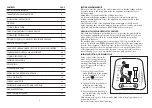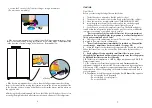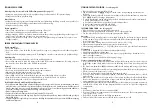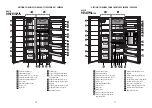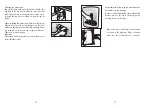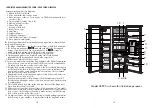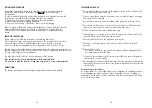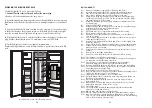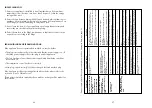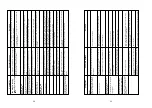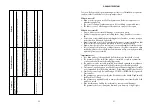
ENERGY SAVING TIPS
1-
Ensure your appliance is installed in a well ventilated area. If the ambient
temperature is low (but in no case lower than 5 degrees C), then the energy
saving will be more.
2-
Ensure the time between buying chilled/frozen food and placing them in your
appliance is kept at minimum, particularly in summer. We recommend you use
a cool bag or a special carrier bag to carry frozen food.
3-
Do not leave the door (s) of your appliance open longer than necessary and
ensure they are closed properly after each opening.
4-
Defrost frozen food in the fridge compartment, so that frozen food acts as an
ice pack to assist cooling in the fridge.
PROBLEM SOLVING AND TROUBLE SHOOTING
If the appliance does not operate when switched on, check whether:
• The plug is inserted properly in the socket and that the power supply is on. (To
check the power supply to the socket, plug in another appliance)
• The fuse has blown/circuit breaker has tripped/main distribution switch has
been turned off.
• The temperature control has been set correctly.
• New plug is wired correctly if you have changed the fitted moulded plug.
If the appliance is still not operating after the above checks, please refer to the
section on “How To Obtain Service”.
Please ensure that above checks have been made as a charge will be made if no
fault is found.
26
Please read this list carefully before calling for service. See Guarantee Details on page 31.
Complaint
Possible Reason
Solution
Compressor is not running
The fridge is running frequently or for a long time.
The fridge is in defrost cycle.
The appliance is not plugged into the socket.
There is a power failure.
Y
our new refrigerator may be biger than the
previous one.
The room or the outside temperature may be high.
The refrigerator might have been plugged in recently
.
Large amounts of hot food might have been put in the refrigerator recently
.
Doors might have been opened frequently or left ajar for a long time.
Freezer or fridge compartment door might have been left ajar
.
This is normal for a full-automatically defrosting refrigerator
.
Defrosting cycle occurs periodically
.
Be sure that the plug is properly insert it into the socket.
Call your electricity supplier
.
This is quite normal. bigger refrigerators operate for longer times.
Such running of the refrigerator under these conditions is quite normal.
Cooling down of the refrigerator completely may last for a couple of hours longer
.
Hot food causes longer running of the refrigerator until they reach the desired temperature.
The warm air that has entered into the refrigerator causes the refrigerator to run for longer periods. Open the doors less freq
uently
.
Check door closes fully
.
Freezing of the food in the bottom drawer (crisper / zero degree compartment) of the fridge compartment.
Ambient temperature is very low (around or lower than 10 ºC)
• Switching the adjustment slider to the crisper position. • Moving the vegetables from this compartment to the upper crisper
.
• Crystallization on the outer surfaces of foodstuf
f such as meat
is normal. •
This is normal if the adjustment slider is at Chiller Compartment
(0ºC) position.
Condensation on the side wall of the fridge compartment. W
ipe the
condensation using a dry cloth.
• V
ery cold ambient conditions.
• Frequent opening and closing of the door
.
• Highly humid ambient conditions. • Storage of food containing liquid in open containers. • Leaving the door ajar
.
• Switching the thermostat to a colder degree. (2 or 4 ºC) • Decreasing the time the door is left open or using it less frequently
.
• Covering the food stored in open containers with a suitable material.
27



